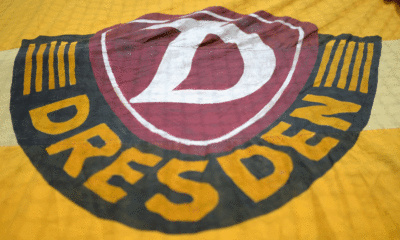Bundesliga
“My friends admire me for my job”
Published
2 years agoon
By
Maria Keane
Petra Stüker is the longest-serving employee at Borussia Dortmund. The 64-year-old, who has been looking after the supporters of the Black and Yellows for a long time as a fan representative, has been working for BVB since 1981. In an interview with SPOX and GOAL Stüker talks about fan support and hooligans in the 1980s, the near bankruptcy in 2005, unusual fan club visits and tells anecdotes about Jürgen Klopp and Tomas Rosicky.
Ms. Stüker, on your 24th birthday in 1981 you started working for BVB as a native of Dortmund. What did you do before?
Petra Stüker: I was employed by my father, who ran the representative office of a mortgage bank. There I quickly realized that this was not my thing and went to commercial college. Incidentally, I was part of the crew of the information stand on the forecourt of the former Westfalenstadion through our BVB fan club. That was the fan meeting point at that time! When someone went to the club’s office, our fan club chairman, who occasionally helped out there, suggested asking me a question. I then introduced myself on Thursdays and started working as a commercial clerk on Mondays. For me as a BVB fan that was the absolute dream.
So the club played a big role in your life before?
Stüker: Clear. My whole family consisted of BVB fans, although only my uncle had a season ticket. A lot of football was watched at home. When I was around 20 years old, I met the chairman of a fan club who asked me if I wanted to join. I did that and immediately became secretary. We went to the home games and also drove away – that’s how it started.
Your workplace then became the office, which was located under the north stand. How was it then there?
Stüker: Very familiar. The office consisted of two rooms. When I started there were four of us. Everyone did basically everything. Mainly it was telephone service and ticket sales. I also took care of insurance matters such as reporting an accident to the employers’ liability insurance association if a player was injured.
On your very first day, you received a call from the head coach at the time, Branko Zebec, but did not recognize him. Do tell!
Stüker: I sat next to it for two hours and had to watch my colleagues use the phone. When I took over the caller said: Hello, this is the trainer, please can I speak to Mr. Wüst? I replied: Which coach, Borussia has a lot of coaches? I ended up connecting him to my colleague who was something of the office manager. He clarified the matter with him, but came up to me and said: The head coach told me that the young lady on the phone didn’t know who the coach at Borussia Dortmund is! (laughs) I would have loved to go home again.
Did you get close to the players in everyday life?
Stüker: There wasn’t a team supervisor like today, so players and coaches always came to us with a wide variety of concerns. Sometimes they wanted to buy tickets for friends, sometimes it was about insurance or we helped new players find an apartment. Since the club was still so small, everyone always took part in the Christmas celebrations, so that you had regular contact with everyone who played or worked for the club.
Which player or coach did you have the best relationship with at the time?
Stüker: Despite the phone call, I got along very well with Zebec and also took care of his grandchildren from time to time. I even did private mail for Erich Ribbeck, and I got on well with Karl-Heinz Feldkamp. It was the first coach discharge that I had to witness. I was so stunned that he had to comfort me. Girl don’t take it so hard, he said! (laughs) I am still friends with Marcel Raducanu, who once needed special care after his escape from Romania and from time to time struggled with his fate because he was no longer allowed to go back to his homeland.
When did your tasks change for the first time?
Stüker: When BVB moved into a small building next to the stadium towards the end of the 1980s, which also housed the youth department and managers, coaches, press officers and I had offices. Together with the long-time team manager Fritz Lünschermann, I then did the press and public relations work, produced the stadium newspaper, marketed perimeter advertising, looked after fan clubs and our advertising pool for sponsors – sort of marketing and merchandising, only that was not called that at the time. That was a tough time in terms of workload.
How were you then positioned in the area of fan articles?
Stüker: We had sold the rights to a company that put out various fan articles and we sold some of them in the office. These were mainly pins, stickers, team posters and scarves. As for jerseys, I still remember how Fritz Lünschermann once ordered a lot of jerseys a few years later and our treasurer almost passed out when he saw the bill. You would never sell that! But a little later they were all gone like hot cakes.
Has there already been fan support?
Stüker: In principle not. In 1974 the BFC – Borussia Fan Club was founded. This quickly grew very large, united many fans and also ensured that the number of members rose because only club members were allowed to become members of the fan club. The BFC later organized the first trips away from home with reduced prices for young people and took disabled people with them. With the help of the BFC, the first daycare center in the stadium of a Bundesliga club was also built in Dortmund.
When did the club finally start looking after fans?
Stüker: In 1986 we started officially accepting the 60 fan clubs at the time – today we have 980 worldwide, 200 of them abroad. We constantly provided them with information, answered their inquiries, later handed out the stadium magazines to them and started the fan club visits. You could then order day or season tickets as a whole fan club. With the title wins in the 1990s, the topic really picked up speed again, because there was an insane explosion and we suddenly had 600 fan clubs.
Were the requirements for being officially recognized as a fan club always the same?
Stüker: In the beginning you needed seven members and an elected board, later and until now there have to be at least 15 members. However, the conditions have become tougher since 2014. Today we need a proper statute, which must definitely contain an anti-racism paragraph. You are required to submit a large number of documents each year, such as an activity report. Today a fan club is judged not by how long it has existed, but by how active it is. This is what the fan clubs have to tell us, because we use this to create a ranking and then finally the cards are distributed.


Test match tournament on free TV and live stream
In preparation for the upcoming start of the season in the 2nd and 3rd divisions, SpVgg Unterhaching is organizing a...


Test match on free TV and live stream
Third division club Dynamo Dresden are testing today against top Czech club Slavia Prague in preparation for the upcoming start...


When does the season start?
It’s warm and sunny outside, but you just want to watch football again? Then get in the mood for the...

